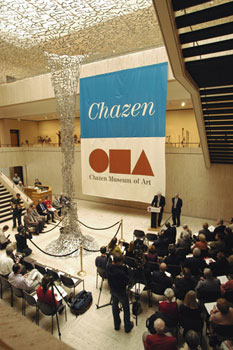Year in Review 2004-2005
April 2005
The world’s oldest rock, a tiny grain of zircon crystal whose study changed scientific views of early Earth, goes on display at the Geology Museum. Measuring little more than two human hairs in diameter, the grain was found in the Jack Hills region of Australia and is estimated to be 4.4 billion years old.
The School of Journalism and Mass Communications celebrates its centennial year with a weekend of special events, including speeches from Chancellor John Wiley, Gov. Jim Doyle, Director James Baughman and New York Times managing editor and UW–Madison alumnus John Geddes.
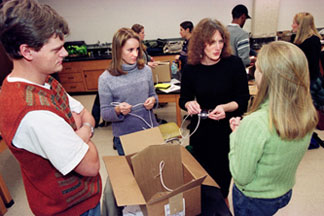
A curriculum and instruction class
Several UW–Madison graduate academic programs receive high rankings from U.S. News and World Report. The Department of Sociology is ranked No. 1 in the country, and specialty programs in curriculum and instruction and women’s studies also boast top rankings.
Peter Spear, provost and vice chancellor for academic affairs, announces plans to retire. Spear’s achievements as provost include results in campus diversity, science education and faculty retention.
The U.S. Department of Education awards UW–Madison with a five–year, $5 million grant to fund an interdisciplinary training program in the education sciences, to be housed at the Wisconsin Center for Education Research in the School of Education.
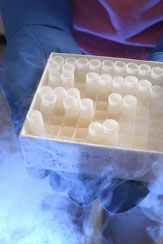
Stem cell research
UW–Madison alumnus William C. Campbell is chosen to receive an honorary degree from the university for his discovery of the drug ivermectin, which takes down river blindness in humans, heartworm in dogs, and numerous parasites in horses and other livestock.
UW–Madison adds two new stem cell programs: a regenerative medicine program and interdisciplinary postdoctoral training program that will advance stem cell research across the university.
Michael Thornton, professor of Afro–American studies, is named the new faculty director of the Morgridge Center for Public Service. He hopes to integrate the center into the academic curriculum by expanding service learning and community–based research.
May 2005
A $20 million gift from alumni Simona and Jerome Chazen will fund a major expansion of the Elvehjem Museum of Art. To commemorate the gift, the name of the museum becomes the Chazen Museum of Art. The gift equals more than half of the estimated $35 million needed for the expansion, which will be a new 60,000–square–foot building across Murray Street east of the existing museum, doubling the museum’s current gallery space.
Julie Underwood, associate executive director and general counsel for the National School Boards Association, is named the new dean of the School of Education.
June 2005
UW–Madison launches a newly redesigned main Web site — the biggest overhaul of the site since 1998.
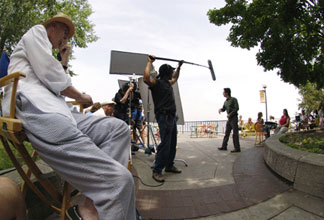
“The Last Kiss” is filmed on campus
Hollywood returns to the campus for production of the film “The Last Kiss,” directed by Paul Haggis and starring Zach Braff, Rachel Bilson, Blythe Danner, Tom Wilkinson and Jacinda Barrett. The film’s producer and executive producer both are UW–Madison alumni.
Luoluo Hong, dean of students since 2002, announces plans to leave UW–Madison for a position at Arizona State University. Lori Berquam, associate dean of students, is named interim dean.
A “traveling classroom” of more than 40 students and faculty venture into the cultural heart of the American West in a course called “The Santa Fe Trail: In Search of the Multiracial West.” The 15–day, 3,000–mile odyssey explores issues of racial diversity and civil rights across a variety of western landmarks in Oklahoma, Texas, New Mexico, Arizona and Colorado.
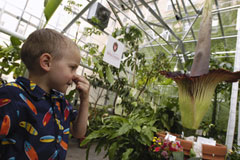
A Titan Arum plant
Against the odds, two of UW–Madison’s Titan Arum plants blossom during June at the Botany Greenhouses, representing the fourth and fifth times that the rare species, also known as “corpse flower” for its signature stench, bloomed at the university since 2001. Both of the June plants had bloomed previously — one in June 2001 and the second in July 2002. A third plant, nicknamed “Little Stinker,” bloomed for the first time in August 2004.
Photos by Jeff Miller and Michael Forster Rothbart, University Communications

